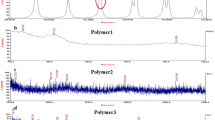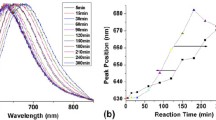Abstract
Mercury is one of the major toxic pollutants and has many adverse effects on human health. The main mercury species in the environment or in living organisms are inorganic mercuric ion (Hg2+) and organic methylmercury (CH3Hg+). Detection of the two mercury ions is a particularly active topic in the molecular sensing field during the past decade. However, efficient sensors that can sensitively detect and discriminate the two species are rare. In this work, we adopt the concept of restriction of intramolecular rotations which is the basis of aggregation induced emission, and design a molecular probe with pyridyl group as the chelating unit and 1,8-naphthalimide as the fluorescent unit for the detection of both Hg2+ and CH3Hg+. When the probe is free in solution, it exhibits weak fluorescence because free intramolecular rotations of the 1,8-naphthalimide moieties non-radiatively annihilate its excited state. However, upon coordination with Hg2+ or CH3Hg+, the rotation of 1,8-naphthalimide moieties would be restricted due to the chelation between 1,8-naphthalimide and Hg2+ or CH3Hg+, leading to significantly enhanced fluorescent emission. The response induced by Hg2+ is much stronger than CH3Hg+; but for specific detection of CH3Hg+, we introduced a T-rich DNA fragment which could completely mask Hg2+ in solution. Furthermore, we have employed the sensor for confocal imaging of Hg2+ and CH3Hg+in immobilized cells. We expect the probe design tactics can be generally useful for sensing many other analytes.
Similar content being viewed by others
References
Tchounwou PB, Ayensu WK, Ninashvili N, Sutton D. Environ Toxicol, 2003, 18: 149–175
Poulain AJ, Barkay T. Science, 2013, 339: 1280–1281
WHO. Guideline Levels for Methylmercury in Fish [S], CAC/GL7-1991; WHO: Geneva, Switzerland, 1991; p 1
Bakir F, Damluji SF, Amin-Zaki L, Murtadha M, Khalidi A, Al-Rawi NY, Tikriti S, Dhahir HI, Clarkson TW, Smith JC, Doherty RA. Science, 1973, 181: 230–241
Eto K, Tokunaga H, Nagashima K, Takeuchi T. Toxicologic Pathol, 2002, 30: 714–722
Erxleben H, Ruzicka J. Anal Chem, 2005, 77: 5124–5128
Zhu Z, Chan GCY, Ray SJ, Zhang X, Hieftje GM. Anal Chem, 2008, 80: 7043–7050
Rodrigues JL, Torres DP, de Oliveira Souza VC, Batista BL, de Souza SS, Curtius AJ, Barbosa Jr F. J Anal At Spectrom, 2009, 24: 1414–1420
Li Y, Yin Y, Liu G, Cai Y. Advances in Speciation Analysis of Mercury in the Environment. In Environmental Chemistry and Toxicology of Mercury; Liu G, Cai Y, Driscoll NO, Eds, John Wiley & Sons: Hoboken, NJ, 2012; pp 15–58
Guo X, Qian X, Jia L. J Am Chem Soc, 2004, 126: 2272–2273
Yang YK, Yook KJ, Tae J. J Am Chem Soc, 2005, 127: 16760–16761
Nolan EM, Lippard SJ. J Am Chem Soc, 2007, 129: 5910–5918
Ando S, Koide K. J Am Chem Soc, 2011, 133: 2556–2566
Kim IB, Bunz UHF. J Am Chem Soc, 2006, 128: 2818–2819
Dave N, Chan MY, Huang PJJ, Smith BD, Liu J. J Am Chem Soc, 2010, 132: 12668–12673
Lee JS, Han MS, Mirkin CA. Angew Chem Int Ed, 2007, 46: 4093–4096
Xue X, Wang F, Liu X. J Am Chem Soc, 2008, 130: 3244–3245
Li D, Wieckowska A, Willner I. Angew Chem Int Ed, 2008, 47: 3927–3931
Song C, Yang B, Yang Y, Wang L. Sci China Chem, 2016, 59: 16–29
Ono A, Togashi H. Angew Chem Int Ed, 2004, 43: 4300–4302
Liu J, Lu Y. Angew Chem Int Ed, 2007, 46: 7587–7590
Hollenstein M, Hipolito C, Lam C, Dietrich D, Perrin DM. Angew Chem Int Ed, 2008, 47: 4346–4350
Chen P, He C. J Am Chem Soc, 2004, 126: 728–729
Wang Y, Cui Y, Liu R, Gao F, Gao L, Gao X. Sci China Chem, 2015, 58: 819–824
Yang YK, Ko SK, Shin I, Tae J. Org Biomol Chem, 2009, 7: 4590–4593
Santra M, Ryu D, Chatterjee A, Ko S-K, Shin I, Ahn KA. Chem Commun, 2009, 2115–2117
Lin YH, Tseng WL. Anal Chem, 2010, 82: 9194–9200
Climent E, Marcos MD, Martínez-Máñez R, Sancenón F, Soto J, Rurack K, Amorós P. Angew Chem Int Ed, 2009, 48: 8519–8522
Liu Y, Chen M, Cao T, Sun Y, Li C, Liu Q, Yang T, Yao L, Feng W, Li F. J Am Chem Soc, 2013, 135: 9869–9876
Cho ES, Kim J, Tejerina B, Hermans TM, Jiang H, Nakanishi H, Yu M, Patashinski AZ, Glotzer SC, Stellacci F, Grzybowski BA. Nat Mater, 2012, 11: 978–985
Deng L, Li Y, Yan X, Xiao J, Ma C, Zheng J, Liu S, Yang R. Anal Chem, 2015, 87: 2452–2458
Zhang Z, Zhang B, Qian X, Li Z, Xu Z, Yang Y. Anal Chem, 2014, 86: 11919–11924
Nolan EM, Lippard SJ. Chem Rev, 2008, 108: 3443–3480
Hancock RD. Chem Soc Rev, 2013, 42: 1500–1524
Liu Z, Zhang C, Li Y, Wu Z, Qian F, Yang X, He W, Gao X, Guo Z. Org Lett, 2009, 11: 795–798
Hong Y, Lam JWY, Tang BZ. Chem Soc Rev, 2011, 40: 5361–5388
Wanichacheva N, Prapawattanapol N, Sanghiran Lee V, Grudpan K, Petsom A. J Luminescence, 2013, 134: 686–690
Wen S, Zeng T, Liu L, Zhao K, Zhao Y, Liu X, Wu HC. J Am Chem Soc, 2011, 133: 18312–18317
Zeng T, Li T, Li Y, Liu L, Wang X, Liu Q, Zhao Y, Wu HC. Nanoscale, 2014, 6: 8579–8584
Frisch MJ, Trucks GW, Schlegel HB, Scuseria GE, Robb MA, Cheeseman JR, Scalmani G, Barone V, Mennucci B, Petersson GA, Nakatsuji H, Caricato M, Li X, Hratchian HP, Izmaylov AF, Bloino J, Zheng G, Sonnenberg JL, Hada M, Ehara M, Toyota K, Fukuda R, Hasegawa J, Ishida M, Nakajima T, Honda Y, Kitao O, Nakai H, Vreven T, Montgomery JA Jr, Peralta JE, Ogliaro F, Bearpark M, Heyd JJ, Brothers E, Kudin KN, Staroverov VN, Keith T, Kobayashi R, Normand J, Raghavachari K, Rendell A, Burant JC, Iyengar SS, Tomasi J, Cossi M, Rega N, Millam JM, Klene M, Knox JE, Cross JB, Bakken V, Adamo C, Jaramillo J, Gomperts R, Stratmann RE, Yazyev O, Austin AJ, Cammi R, Pomelli C, Ochterski JW, Martin RL, Morokuma K, Zakrzewski VG, Voth GA, Salvador P, Dannenberg JJ, Dapprich S, Daniels AD, Farkas O, Foresman JB, Ortiz JV, Cioslowski J, Fox DJ. Gaussian 03: Gaussian, Inc., Wallingford, CT. 2004
Author information
Authors and Affiliations
Corresponding author
Additional information
These authors contributed equally to this work
Rights and permissions
About this article
Cite this article
Yang, Y., Yao, Z., Li, W. et al. Selective detection of mercury(II) and methylmercury(II) via coordination-induced emission of a small-molecule probe. Sci. China Chem. 59, 1651–1657 (2016). https://doi.org/10.1007/s11426-016-0137-y
Received:
Accepted:
Published:
Issue Date:
DOI: https://doi.org/10.1007/s11426-016-0137-y




